

Turkey Feathers |
Turkey Quills and Tails |
Mottled Quills are used for hopper, muddler, and caddis wings as well as wing cases on nymphs. The Barred Quills are dyed to different colors and are usually used for hopper legs. |
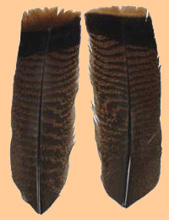 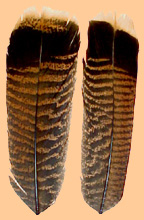 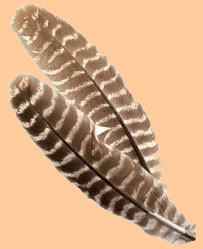 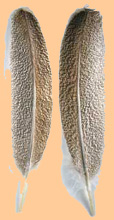
|
| Cinnamon Tip Turkey Tail Mottled White Tipped Turkey Tail Ozark Barred Turkey Quill Mottled Oak Turkey Quill |
Turkey Biots |
|
Turkey Flats |
These broad square tipped feathers located on the lower back of the turkey. Flats are used for parachute, thorax and divided wing dry flies. They are durable, easy to work with and produce a good wing silhouette. Mottled turkey flats have a flecked pattern that duplicates subtle markings found on the wings of numerous natural insects. |
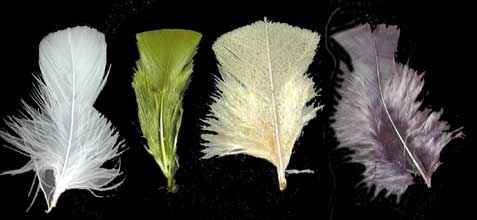 |
| White Flat Olive Flat Mottled Oak Flat Dun Flat |
Duck Feathers |
Mallard |
Mallard Flank can be used for dry fly wings, parachute posts, tails, legs and wingcases. It is dyed for an imitation woodduck material as well as many others colors. Dyed Mallard Flank Colors Available |
 |
| Olive dyed Mallard Flank Natural Mallard Flank Woodduck dyed Mallard Flank Bronze Mallard Shoulder |
Woodduck |
Woodduck is a Noth American duck very similar to it's Asian cousin, the Mandarin Duck. The flank feathers are particularly prized due to color, barring, and texture. Feathers will vary in size and shape. Selection of the type of feather is important as to what type of wing can be tied with the material. The Barred Lemon Woodduck is traditionally used for dry fly wings and tailing materials on mayfly nymphs. The Barred Black/White Woodduck is often used within Atlantic Salmon patterns. The material is used for dry and wet flies, streamers, and Nymphs. The mottling and coloration are of the woodduck is an important attribute for the legs and tailing of mayfly nymphs and emergers. While Mallard Flank is dyed to a Imitation Woodduck, it cannot substitute the texture and barring characteristics of the real thing. |
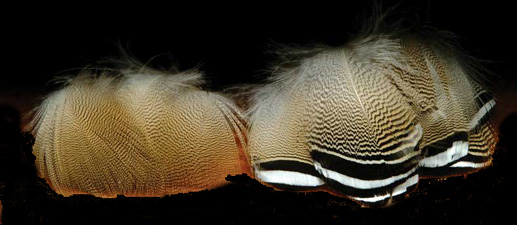 |
| Barred Lemon Woodduck Flank Barred Black/White Woodduck Flank |
CDC (Cul de Canard) Feathers |
CDC are feathers found around the oil gland of the duck near the butt. They contain many fine fibers which give the feathers great floatability. The supple nature of the feathers also give them special movement in the water and closely resemble the leg movements of many insects.The use of CDC can be found within patterns for Caddis, Mayflies, and Comparaduns. Usually the material is tied in conjunction with another support material such as deer hair or partridge. The CDC is available in a number of dyed colors. CDC Colors Available |
 |
Pheasant Feathers |
Ringneck Pheasant Tails |
Ringneck Pheasant Tail feathers have thick-barbed fibers with brown, olive, and black colorations. The barbs are used for tailing materials, legs, and bodies. Perhaps, the most well known use is on the Pheasant Tail Nymph which is constructed entirely from Pheasant Tail fibers with a ribbing of gold wire. Tails are dyed in many colors such as Black, Brown, Green, Olive, Orange, Purple, Red, or Yellow. |
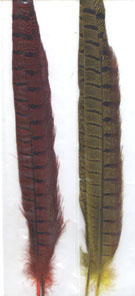 |
Partridge Feathers |
Hungarian Partridge |
Hungarian Partridge is the most widely used soft hackle. It comes in shades of brown and gray with fine speckles and barrs. The fibers are straight and will flare when turned as a hackle. A skin is generally preferred since size and selection is easier.The hackles are used for tails, wings, wing-cases hackle, and bodies. Dyed Partridge skins are available in Brown, Olive, Burnt Orange, Caddis Green , Bleached Ginger, and Yellow. |
 
|
Peacock Feathers |
Herl and Swords |
Peacock Herls are the fringy feather parts on the shaft of a Peacock Tail Feather. They are small irridiscent fibers with green, copper, bronze, and blue highlights. Herls are used for bodies such as the Prince Nymph. They are also used as Thorax materials on many nymphs. Peacock Swords are finged green feathers that line the edge of the peacock fan. It is usedd for tailing material on flies such as the Zug Bug. Eyes can have both herl material and sword material within them. |
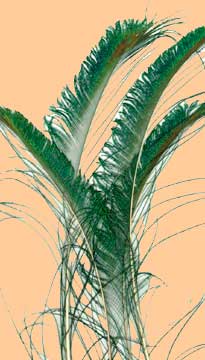 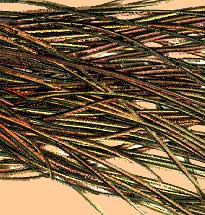 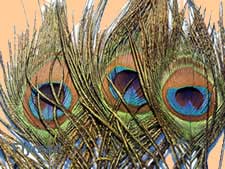
|
| Peacock Sword Peacock Herl Peacock Eyes |